Ontario Alignment By Overall Expectation
Introducing the Area of a Trapezoid and/or Composite Figures in 3 Acts
Here we are in week 3 of the #Canada150Math Challenge and after finally moving west to North Vancouver to mathematize the Canada 150 Mountie salute on the Capilano Suspension Bridge, I thought we should head to the prairies to see what sort of math fun we could have there.
This question was inspired by an old EQAO problem from the Winter 2007 Applied Assessment of Mathematics about the area of Saskatchewan:
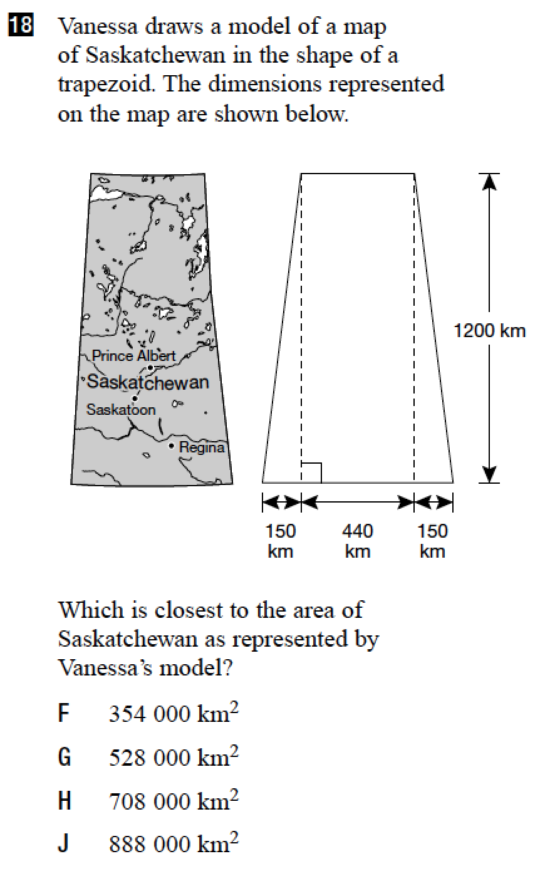
Doesn’t quite generate that mathematical excitement I am typically looking for, but still a worthwhile problem. I’m thinking we could have a lot of fun with this and maybe even spark some curiosity at the same time.
Act 1: Introduce the Task
#Canada150Math Challenge Day #9: Tuesday June 13th, 2017
Show students the act 1 video.
Then ask students to do a rapid write of what they notice and what they wonder. Alternatively, you might have students simply chat this out with their neighbours.
Hopefully students will generate some great noticings and wonderings. I’m hoping that we’ll be able to steer some of the inquiry around the area of Saskatchewan based on this additional video I would show:
Since we’re zoomed in on Saskatchewan with Wanuskewin Heritage Park highlighted, hopefully some noticings and wonderings about that location may arise.
While some questions like the following may arise:
What is the area of Saskatchewan?
or
What percentage of Canada does Saskatchewan represent?
I’m hoping to eventually get to some questions involving First Nation, Metis and Inuit (FNMI) peoples. With this being Canada’s 150th Birthday, I believe it is important that we acknowledge those who were here before us and recognize the very small area of Canadian soil that is reserved for these groups.
So while it might be useful to have students do some comparisons like what percentage of Canada’s land is considered to be Saskatchewan, I hope we can get to some questions regarding the FNMI peoples on the next day.
Act 2: Sharing Some Details
If you’re hoping to do some of those initial comparisons to relate the area of Saskatchewan to Canada, you might want to show these:
Some other questions you might consider on this day:
How many “Saskatchewans” would it take to cover all of Canada?
Which has a greater area? Your province or Saskatchewan?
Which has a greater population density? Your province or Saskatchewan?
Act 3: The Reveal
No full visual solution created for this task (YET). However, I do have a Visualizing the Area of a Trapezoid video you might find useful:
Did you come up with some cool solutions in your class?
Reply in the comments and share out your work. I’d love to post it here!
Sequel: What Percentage of Canadian Land Is Protected for FNMI Peoples?
#Canada150Math Challenge Day #10: Wednesday June 14th, 2017
Show students this image:
You can print out a map of Saskatchewan and have them shade in the portion they believe represents the area reserved for FMNI peoples. You might want to remind them of their area calculation from the last day for them to consider.
You might want to have students calculate the percentage as a comparison.
Then, you can have them do the same thing for Canada:
Hopefully students will realize that the amount of land dedicated for the people who were here before confederation is really small.
Why might that be?
You might have students do some research to determine approximately how many FNMI people are in Canada. What proportion of the Canadian population does this represent?
Is that percentage in line with the percentage of land dedicated for the FNMI peoples?
If not, what area of land should be reserved for FNMI people?
Can you think of more questions that students should be thinking about as we continue through our Month of Math this June during Canada’s 150th Birthday?
Be sure to check back to my blog, the GECDSB Canada150Math page and follow the @Canada150Math Twitter account and #Canada150Math hashtag to access a new math question or provocation each weekday throughout the month. We hope you’ll share photos of students engaging in Canada150Math tasks and their thinking so we can re-tweet with the rest of Canada!
New to Using 3 Act Math Tasks?
Download the 2-page printable 3 Act Math Tip Sheet to ensure that you have the best start to your journey using 3 Act math Tasks to spark curiosity and fuel sense making in your math classroom!
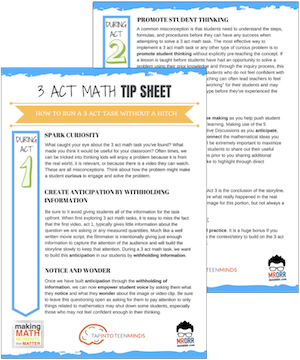
Share With Your Learning Community:

About Kyle Pearce
I’m Kyle Pearce and I am a former high school math teacher. I’m now the K-12 Mathematics Consultant with the Greater Essex County District School Board, where I uncover creative ways to spark curiosity and fuel sense making in mathematics. Read more.
Access Other Real World Math Tasks
Search More 3 Act Math Tasks
Grade 2 [2.B1.1, 2.B1.3, 2.B2.1, 2.B2.2, 2.B2.3, 2.B2.4, Measurement - M1, Number Sense and Numeration - NS1, Number Sense and Numeration - NS2, Number Sense and Numeration - NS3]
Grade 3 [3.B1.5, 3.B2.1, 3.B2.3, 3.B2.7, Measurement - M1, Number Sense and Numeration - NS1, Number Sense and Numeration - NS3]
Grade 4 [4.B2.1, 4.B2.4, 4.E2.5, 4.E2.6, Measurement - M1, Number Sense and Numeration - NS1, Number Sense and Numeration - NS3, Patterning and Algebra - PA2]
Grade 5 [5.B1.7, 5.B2.9, 5.D1.3, 5.D1.6, 5.E2.6, 5.F1.2, 5.F1.5, Measurement - M1, Measurement - M2, Number Sense and Numeration - NS1, Number Sense and Numeration - NS3, Patterning and Algebra - PA2]
Grade 6 [6.B2.12, 6.B2.9, Data Management and Probability - DP3, Measurement - M1, Measurement - M2, Number Sense and Numeration - NS1, Number Sense and Numeration - NS2, Number Sense and Numeration - NS3, Patterning and Algebra - PA1, Patterning and Algebra - PA2]
Grade 7 [7.B1.3, 7.B1.4, 7.B1.7, 7.B2.2, 7.B2.3, 7.C1.1, 7.C1.2, 7.C1.3, 7.C1.4, 7.D1.6, Data Management and Probability - DP3, Geometry and Spatial Sense - GS1, Measurement - M1, Measurement - M2, Number Sense and Numeration - NS1, Number Sense and Numeration - NS2, Number Sense and Numeration - NS3, Patterning and Algebra - PA1, Patterning and Algebra - PA2]
Grade 8 [8.B1.4, 8.B2.5, 8.C1.1, 8.C1.2, 8.C1.3, 8.C1.4, Data Management and Probability - DP1, Data Management and Probability - DP3, Geometry and Spatial Sense - GS2, Measurement - M1, Measurement - M2, Number Sense and Numeration - NS1, Number Sense and Numeration - NS2, Number Sense and Numeration - NS3, Patterning and Algebra - PA1, Patterning and Algebra - PA2]
Grade 9 [9.B3.5, 9.C3.1, 9.C3.2, 9.C3.3]
Kindergarten [k.15.1, k.15.10, k.15.2]
MAP4C [Mathematical Models - MM1, Mathematical Models - MM2, Mathematical Models - MM3]
MAT1LMAT2LMBF3C [Data Management - DM1, Data Management - DM2, Geometry and Trigonometry - GT1, Geometry and Trigonometry - GT2, Mathematical Models - MM1, Mathematical Models - MM2, Mathematical Models - MM3]
MCF3M [Exponential Functions - EF2, Quadratic Functions - QF1, Quadratic Functions - QF2, Quadratic Functions - QF3, Trigonometric Functions - TF1, Trigonometric Functions - TF3]
MCR3U [Characteristics of Functions - CF1, Characteristics of Functions - CF2, Exponential Functions - EF2, Exponential Functions - EF3, Trigonometric Functions - TF3]
MCT4C [Exponential Functions - EF1, Trigonometric Functions - TF3]
MCV4U [Derivatives and Their Applications - DA2]
MDM4U [Counting and Probability - CP2, Organization of Data For Analysis - DA2, Probability Distributions - PD1, Statistical Analysis - SA1, Statistical Analysis - SA2]
MEL4EMFM1P [Linear Relations - LR1, Linear Relations - LR2, Linear Relations - LR3, Linear Relations - LR4, Measurement and Geometry - MG1, Measurement and Geometry - MG2, Measurement and Geometry - MG3, Number Sense and Algebra - NA1, Number Sense and Algebra - NA2]
MFM2P [Measurement and Trigonometry - MT1, Measurement and Trigonometry - MT2, Measurement and Trigonometry - MT3, Modelling Linear Relations - LR1, Modelling Linear Relations - LR2, Modelling Linear Relations - LR3, Quadratic Relations in y = ax^2 + bx + c Form - QR1, Quadratic Relations in y = ax^2 + bx + c Form - QR2, Quadratic Relations in y = ax^2 + bx + c Form - QR3]
MHF4U [Characteristics of Functions - CF3, Exponential and Logarithmic Functions - EL2, Exponential and Logarithmic Functions - EL3]
MPM1D [AG3, Analytic Geometry - AG1, Analytic Geometry - AG2, LR1, LR2, LR3, MG1, MG2, MG3, NA1, Number Sense and Algebra - NA2]
MPM2D [AG1, AG2, AG3, QR2, Quadratic Relations - QR3, Quadratic Relations - QR4, T2, T3]
Functions [F-BF.1, F-BF.3, F-IF.4, F-LE.1, F-LE.2, F-LE.3, F-TF.5]
Geometry [G-C.5, G-C.8, G-C.9, G-GMD.3, G-GMD.4, G-GPE.4, G-GPE.5, G-GPE.7, G-MG.1, G-MG.2, G-SRT.11]
Grade 1 [1.NBT.4, 1.OA.1, 1.OA.6, 1.OA.A.1, 1.OA.B.3, 1.OA.B.4, 1.OA.C.5, 1.OA.C.6]
Grade 2 [2.NBT.5, 2.NBT.B.5, 2.NBT.B.8, 2.NBT.B.9, 2.OA.2, 2.OA.A.1, 2.OA.B.2]
Grade 3 [3.MD.C.5, 3.NBT.2, 3.NF.1, 3.NF.2, 3.NF.3, 3.NF.A.1, 3.OA.1, 3.OA.5, 3.OA.9]
Grade 4 [4-MD.3, 4.MD.1, 4.MD.2, 4.NBT.6, 4.NF.3, 4.NF.5, 4.NF.6, 4.OA.1, 4.OA.5]
Grade 5 [5.B1.7, 5.D1.3, 5.D1.6, 5.MD.1, 5.MD.3, 5.MD.4, 5.MD.5, 5.NBT.2, 5.NBT.3, 5.NBT.6, 5.NBT.7, 5.NF.1, 5.NF.2, 5.NF.3, 5.NF.4, 5.NF.5, 5.OA.1, 5.OA.2, 5.OA.3]
Grade 6 [6.EE.1, 6.EE.2, 6.EE.5, 6.EE.6, 6.EE.7, 6.G.1, 6.G.2, 6.NS.1, 6.NS.3, 6.NS.6, 6.NS.B.3, 6.NS.C.6, 6.NS.C.7, 6.NS.C.8, 6.RP.1, 6.RP.2, 6.RP.3, 6.RP.A.1, 6.RP.A.2, 6.RP.A.3, 6.RP.A.3.C]
Grade 7 [7.EE.3, 7.EE.4, 7.EE.A.1, 7.G.3, 7.G.4, 7.G.6, 7.NS.A.1, 7.NS.A.2, 7.RP.1, 7.RP.3, 7.RP.A.2.B, 7.RP.A.3, 7.SP.2, 7.SP.5, 7.SP.6]
Grade 8 [8.EE.1, 8.EE.5, 8.EE.6, 8.EE.7, 8.EE.8, 8.F.2, 8.F.3, 8.F.4, 8.F.5, 8.G.5, 8.G.6, 8.G.7, 8.G.9, 8.SP.1]
Grade 9Kindergarten [K.CC.A.1, K.NBT.A.1, K.OA.A.1, K.OA.A.2, K.OA.A.3]
Practice [MP.1, MP.2, MP.3, MP.4, MP.6, MP.7]
Statistics & Probability [S-ID.6, S-MD.4]

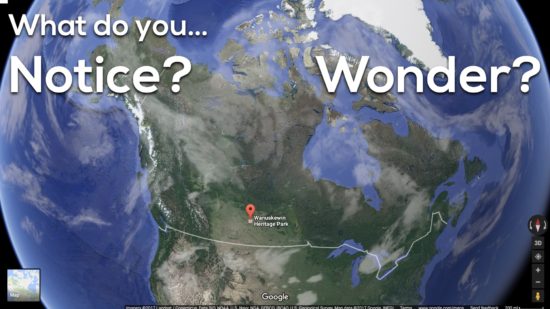
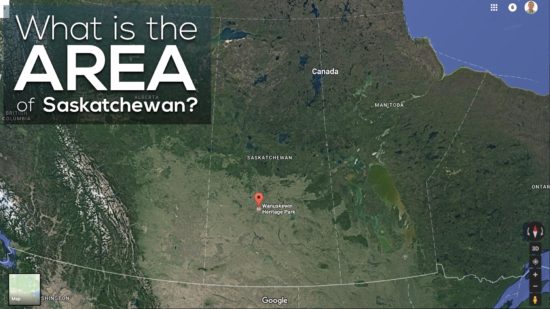

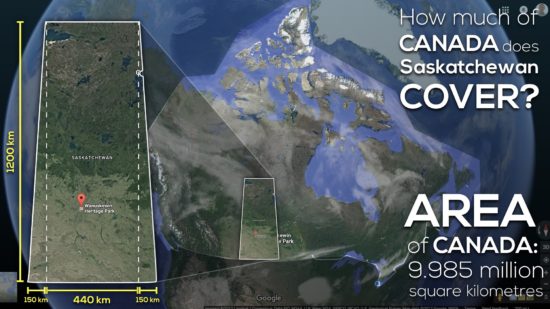
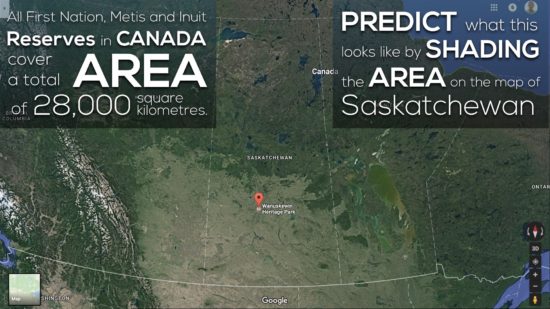
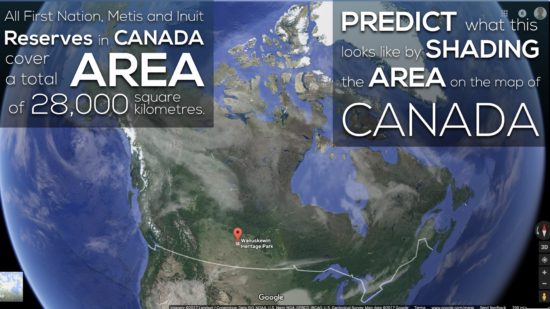
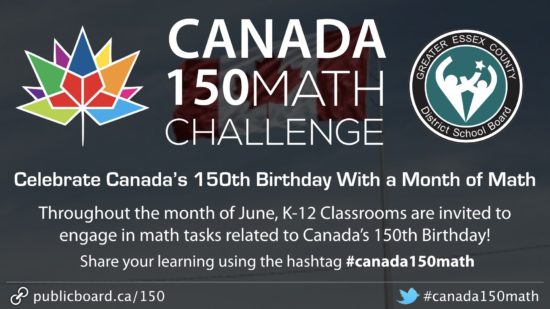
Trackbacks/Pingbacks